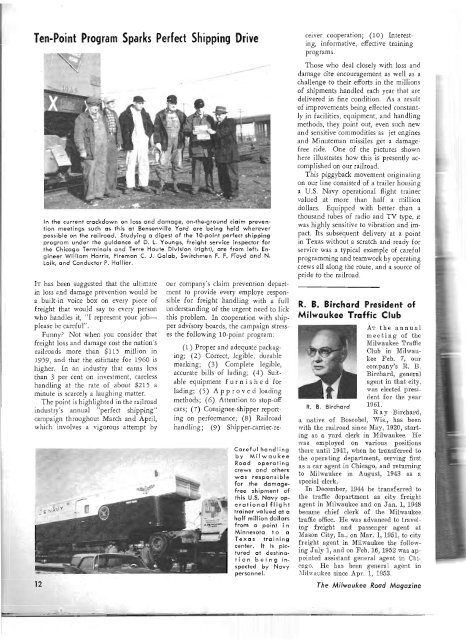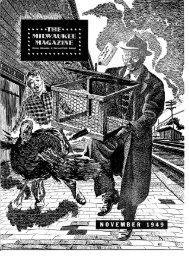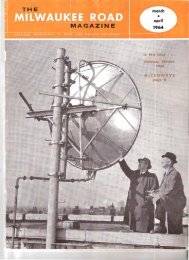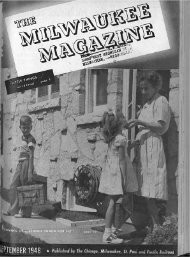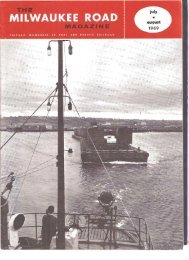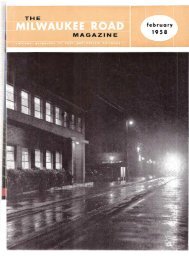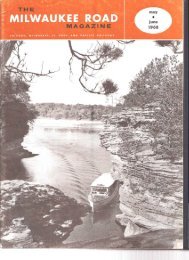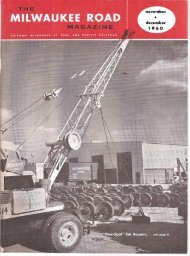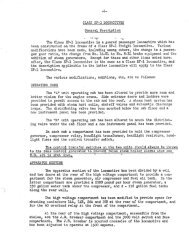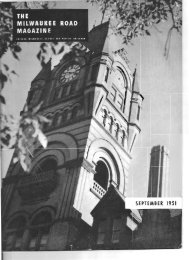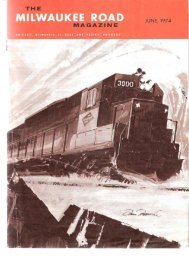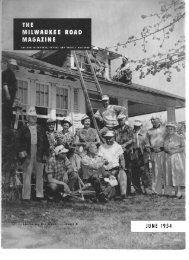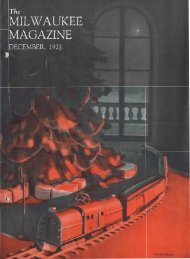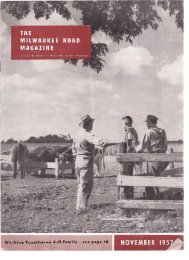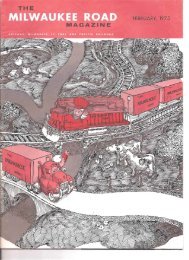March-April, 1961 - Milwaukee Road Archive
March-April, 1961 - Milwaukee Road Archive
March-April, 1961 - Milwaukee Road Archive
Create successful ePaper yourself
Turn your PDF publications into a flip-book with our unique Google optimized e-Paper software.
Ten-Point Program Sparks Perfect Shipping Dl'ive<br />
In the current crackdown on loss and damage, on-the-ground claim prevention<br />
meetings such as this at Bensenville Yard are being held wherever<br />
possible on the railroad. Studying a digest of the 10-point perfect shipping<br />
program under the guidance of D. L. Youngs, freight service inspector for<br />
the Chicago Terminals and Terre Haute Division (right), are from left: Engineer<br />
William Harris, Fireman C. J. Galab, Switchmen F. F. Floyd and N,<br />
Loik, and Conductor P. Hallier.<br />
IT has been suggested that the ultimate<br />
in loss and damage prevention would be<br />
a built-in voice box on every piece of<br />
freight that would say to every person<br />
who handles it, "I represent your jobplease<br />
be careful".<br />
Funny) Not when you consider that<br />
freight loss and damage cost the nation's<br />
railroads more than $115 million in<br />
1959, and that the estimate for 1960 is<br />
higher. In an industry that earns less<br />
than 3 per cent on investment, careless<br />
handling at the rate of about $215. a<br />
minute is scarcely a laughing matter.<br />
The point is highlighted in the railroad<br />
industry's annual "perfect shipping"<br />
campaign throughout <strong>March</strong> and <strong>April</strong>,<br />
which involves a vigorous attempt by<br />
12<br />
our company's claim prevention department<br />
to provide every employe responsible<br />
for freight handling with a full<br />
understanding of the urgent need to lick<br />
this problem. In cooperation with shipper<br />
advisory boards, the campaign stresses<br />
the following la-point program:<br />
(1) Proper and adequate packaging;<br />
(2) Correct, legible, durable<br />
marking; (3) Complete legible,<br />
accurate bills of lading; (4) Suitable<br />
equipment fur n ish e d for<br />
lading; (5) A P pro v e d loading<br />
methods; (6) Attention to stop-off<br />
cars; (7) Consignee-shipper reporting<br />
on performance; (8) Railroad<br />
handling; (9) Shipper-carrier-re-<br />
Careful handling<br />
by <strong>Milwaukee</strong><br />
<strong>Road</strong> operating<br />
crews and others<br />
was responsible<br />
for the damagefree<br />
shipment of<br />
this U.S. Navy operational<br />
flight<br />
trainer valued at a<br />
half million dollars<br />
from a point i n<br />
Minnesota to a<br />
Texas training<br />
center. It is pictured<br />
at destinat<br />
ion be i n ginspected<br />
by Navy<br />
personnel.<br />
ceiver cooperation; (10) Interesting,<br />
informative, effective training<br />
programs.<br />
Those who deal closely with loss and<br />
damage cite encouragement as well as a<br />
challenge to their efforts in the millions<br />
of shipments handled each year that are<br />
delivered in fine condition. As a result<br />
of improvements being effected constantly<br />
in facilities, equipment, and handling<br />
methods, they point out, even such new<br />
and sensitive commodities as jet engines<br />
and Minuteman missiles get a damagefree<br />
ride. One of the pictures shown<br />
here illustrates how this is presently accomplished<br />
on our railroad.<br />
This piggyback movement originating<br />
on our line consisted of a trailer housing<br />
a U.S. Navy operational flight trainer<br />
valued at more than half a million<br />
dollars. Equipped with better than a<br />
thousand tubes of radio and TV type, it<br />
was highly sensitive to vibration and impact.<br />
Its subsequent delivery at a point<br />
in Texas without a scratch and ready for<br />
service was a typical example of careful<br />
programming and teamwork by operating<br />
crews all along the route, and a source of<br />
pride to the railroad.<br />
R. B. Birchard President of<br />
<strong>Milwaukee</strong> Traffic Club<br />
AT the annual<br />
me e tin g of the<br />
<strong>Milwaukee</strong> Traffic<br />
Club in <strong>Milwaukee</strong><br />
Feb. 7, our<br />
company's R. B.<br />
Birchard, general<br />
agent in that city,<br />
was elected president<br />
for the year<br />
R. B. Birchard <strong>1961</strong>.<br />
R. a y Birchard,<br />
a native of Boscobel, Wis., has been<br />
with the railroad since May, 1920, starting<br />
as a yard clerk in <strong>Milwaukee</strong>. He<br />
was employed on various positions<br />
there until 1941, when he transferred to<br />
the operating department, serving first<br />
as a car agent in Chicago, and returning<br />
to <strong>Milwaukee</strong> in August, 1943 as a<br />
special clerk.<br />
In December, 1944 he transferred to<br />
the traffic department as city freight<br />
agent in <strong>Milwaukee</strong> and on Jan. 1, 1948<br />
became chief clerk of the <strong>Milwaukee</strong><br />
traffic office. He was advanced to traveling<br />
freight and passenger agent at<br />
Mason City, Ia., on Mar. 1, 1951, to city<br />
freight agent in <strong>Milwaukee</strong> the following<br />
July 1, and on Feb. 16, 1952 was appointed<br />
assistant general agent in Chieag-o.<br />
He has been general agent in<br />
:\Iil\\'aukee since Apr. 1, 1953. .<br />
The <strong>Milwaukee</strong> <strong>Road</strong> Magazine


